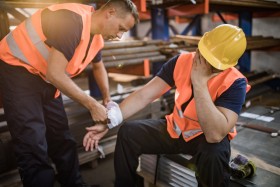Workplace Injury Prevention Tips for Small Business Owners

All workplaces have hazards. It doesn’t matter if you’re working for a large, international corporation or a small business. Both office workers and construction workers can potentially be injured on the job or develop occupational illnesses if proper precautions aren’t taken. Of course, different types of workplaces will have different types of hazards, but the bottom line is that workplace safety needs to always be a priority.
The simple fact of the matter is that embracing safety in the workplace benefits employees and employers alike. Not only does it protect your employees by preventing injuries and other occupational illnesses, it benefits companies by helping them avoid added expenses related to employee injuries, like the costs of lost productivity, legal costs, medical expenses, and the costs of hiring and training a temporary replacement while the injured employee recovers. Far too often, employers cut corners on safety as a way to save money or time, but prevention is always the best approach. Unfortunately, it’s injured employees who end up paying the biggest price.
For small businesses, the overall effects of workplace injuries can be felt much more drastically than they might be for a larger company. The best thing to do is prevent them from happening in the first place. So what are some things small businesses can do to prevent injuries?
Build a Culture of Safety
When hazards exist in a workplace, employees often feel afraid of speaking up. Sometimes, employers will retaliate against those who bring up safety issues by doing things like firing the employee, demoting them, or transferring them to another location, even though such actions are illegal. But when employees feel like safety is a valued concept at their company, it can create a safer environment for everyone by encouraging people to say something about hazards.
A company culture that embraces safety isn’t just about making people feel comfortable about speaking up about dangers in the workplace, it’s also about having strong safety procedures in place and making sure everyone is educated about how to follow them. For example, if a job involves working with machinery or powerful tools, new employees should be trained on how to properly use that equipment and about any safety checklists that should be followed each day. If certifications are needed to operate a certain type of equipment, don’t skirt around those requirements.
Provide Protective Equipment
Another big part of having a culture of safety is making protective equipment readily available. Depending on the workplace, this might mean eye goggles, fall protection gear, or hearing loss protection. Not only does protective equipment need to be available, it needs to be regularly checked to make sure it is still in good, usable condition. If protective equipment gets worn out, it might not work as effectively as it should.
Property Maintenance & Inspections
In many cases, workplace accidents could have been prevented with basic maintenance and routinely checking for potential hazards. In an office, for example, you should check to make sure that things like power cables and boxes aren’t blocking pathways where people walk, that sidewalks are cleared of ice and snow in the winter, and that damaged sidewalk or parking lot pavement is replaced in a timely manner. Or in a factory or warehouse, floors should be frequently checked for slip and trip hazards and damaged equipment should be quickly removed or repaired.
Ergonomic Support
Musculoskeletal injuries are a major type of workplace injury, accounting for about 30% of all workers compensation claims. This includes injuries like carpal tunnel syndrome, pinched nerves, ruptured and herniated discs, hernias, and rotator cuff tendonitis. Often, these types of injuries are caused by things like making repetitive motions in the course of a job, having to do a lot of physical exertion, or improper postures while working.
Unfortunately, ergonomic hazards aren’t always easy to spot. And since they’re often injuries that develop gradually over time, the early symptoms might not seem like a big deal at first. For example, if a person holds their neck in an awkward position because the computer monitors on their desk are too low, they might not really think much of it if they end up with a slightly stiff neck at the end of the day. But over time, that might turn into a bigger problem.
Dealing with ergonomic hazards will depend on the type of work environment, but generally speaking, it’s good to encourage people to take breaks so that they can get up and stretch, help people learn proper movements, and provide people with workstations that can easily be adjusted to suit their needs. Also, encourage people to speak up if they notice any early symptoms of a musculoskeletal disorder. People might feel like they’re being too demanding or nitpicky if they complain about something like a desk chair making their back hurt, but that really is an issue that should be addressed.
Get Help from a Workplace Injury Lawyer
Workplace injury cases can be complicated. If you’ve been injured on the job or have other questions about legal liability in the workplace, contact a workplace injury lawyer for help. A lawyer will be able to help you understand your rights and can work with you to get the compensation you need. At Goodwin & Scieszka, we’ve helped many people who have been in your shoes. Contact us today to get started.
Image: iStock / skynesher






